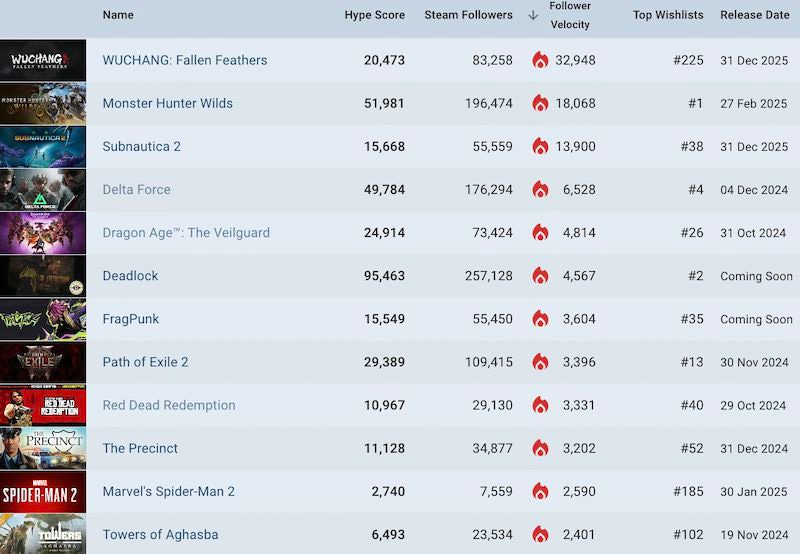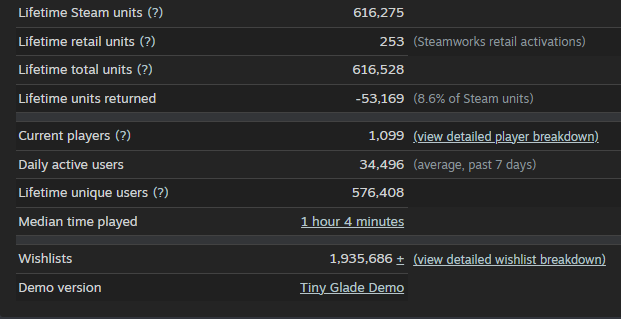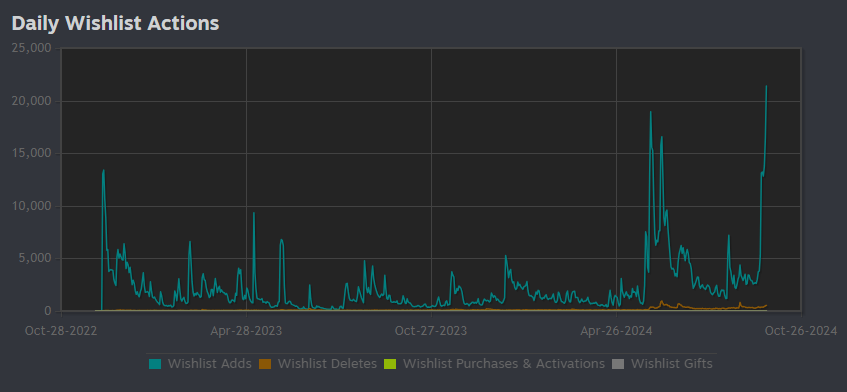How Tiny Glade 'built' its way to >600k sold in a month!
Publikováno: 29.10.2024
Also: a whole heap of game discovery & platform news, & some bonus radical politics.
[The GameDiscoverCo game discovery newsletter is written by ‘how people find your game’ expert & company founder Simon Carless, and is a regular look at how people discover and buy video games in the 2020s.]
We’re back for a new week, and thanks for the feedback on our ‘news up front, party main feature in the back’ newsletter structure, which seems to have gone down well. (We spend a lot of time picking the right news - not all the news - for that section.)
Before we start, we’re going to ask you an important question - should you be sinking your 401k into vTuber stocks? Dungeon Investing is trying to answer that by a deep financial dive into Hololive parent company Cover Corp, whom you might know from hit free Steam fangame HoloCure and that L.A. Dodgers baseball collab. Huh!
[HEADS UP: you can support GameDiscoverCo by subscribing to GDCo Plus right now. You get base access to a super-detailed Steam back -end for unreleased & released games, full access to a second weekly newsletter, Discord access, eight game discovery eBooks & lots more.]
Game discovery news: watch out for Wuchang…
We’re starting out with the latest game platform & discovery news, as is now our rule. And here’s what we’d like to point out:
GameDiscoverCo’s latest ‘trending unreleased Steam games’ chart - sorted by new followers in the last 7 days - shows that Chinese interest in Wuchang: Fallen Feathers, post-Black Myth, is keeping it at #1. (And Monster Hunter Wilds - #2 - leapfrogged the newly announced Subnautica 2 at #3.)
Elsewhere on that chart - viewable daily & sortable by our Plus members - leftover Steam Next Fest interest (Delta Force, #4, The Precinct, #10) and pre-launch surges (Dragon Age: The Veilguard at #5) also feature strongly. And Towers of Aghasba (#12) is an interesting-looking survival crafter debuting in November.
Late-breaking news from PlayStation: Sony has decided to close first-party Concord dev Firewalk Studios, as well as German-based mobile outfit Neon Koi (formerly Savage Game Studios), noting “we will work to find placement for some of those impacted within our global community of studios where possible.”
Veteran journoconsultant Brian Crecente notes that “the gaming console isn't dying; it's just being redefined”, as handheld PCs like Steam Deck get mainstreamed over time. A similar change snuck up for PC laptops - per IDC: “of all PCs shipped in 2023, desktops made up about 30 percent [&] tower computers… were roughly half of that.”
The crew at Stream Hatchet looked at the top Steam Next Fest games in terms of live Twitch streams, noting: “Multiplayer shooter games saw by far the most attention, with hero shooter/MOBA Supervive and tactical shooter Delta Force being the only titles to exceed 1M hours watched.” Fast Food Simulator also saw 506K hours watched..
Now here’s wild UGC crossover for a hit game: "Adobe Express is.. available in Team Builder for [EA’s] College Football 25”, allowing players to customize their team logos & jerseys with royalty-free designs. There’s Adobe upsell, too: “With the free Adobe Express plan, you can create up to 25 custom images for your teams per month."
Here’s a complex article on ‘Steam, aggregators & the game industry’, which laments: “Why publish games from experienced teams with a pedigree when they can’t consistently predict the market through the lens of their expertise, and end up having the same or lower hit rate as any random rookie developer whose meme hobby demo went viral?” (Too much sneering at ‘low quality’ games here for us, tho - the market decides.)
Talking of EA Sports College Football 25, it’s the best-selling American football game ever by U.S. dollar sales, per Circana, and also“the overall #2 best-selling sports game in US history in terms of US dollar sales, bettered only by NBA 2K21.” (GDCo estimates the PS5 version as 93.5% U.S. players, btw - wow, that’s high.)
Roblox things the company’s upcoming creator road map includes in-experience commerce via Shopify, music discovery & in-world video, among other features; Roblox is providing new parental controls for younger kids on the platform, likely planned pre-Hindenburg Research, but good to roll out now.
Just Steam platform things: did you know you can see how much money you’ve spent directly on your Steam account via this link for ‘External Spend’? And did you know you can look up the ‘market value’ of any public Steam account via this SteamDB link? (Be scared.)
Microlinks: Fortnite is allowing you to ‘cross-advance’ your Battle Passes for Fortnite, LEGO Fortnite and Fortnite Festival by using the same XP for all ; Apple “appears to be scaling back production of Vision Pro, and may even halt manufacturing entirely by the end of the year, The Information reports”; short-episode live action ad/content is spreading from the Quibi-like Reelshort to mobile games.
Tiny Glade: a month, >600k copies sold on Steam!
We’re guessing you might have seen Pounce Light’s glorious “relaxing building game”Tiny Glade($15), which Ana Opara and Tomasz Stachowiak launched on Steam on Sept. 23rd, after a two-year dev period and a Top 10 appearance in June’s Next Fest.
We expected the game to do well - but at 10,000+ CCU on launch, and >1,000 CCU even now, it’s doing amazing for a micro-indie. Why? It appealed to the cozy demo, like The Sims streamers (above), wider ‘city builder’ influencers - and has UGC galore, since players are building Helm’s Deep from The Lord Of The Rings in the game.
So we had to contact the devs for a Q&A. They were kind enough to be transparent with their numbers - as of a few days ago - including this Steam back-end overview:
A few things stand out there as impressive or different to the norm:
the 616,000 copies sold in less than a month, pretty much guaranteeing Tiny Glade is selling a million or two over time. (Blimey.)
the big DAU (daily active) number compared to CCU (concurrents) - ~30x, versus 8-10x for stickier titles. (But the game is still 97% Positive in user reviews.)
the median time played of just 1 hour 4 minutes - relatively low, though we know some outliers build for hundreds of hours.
Just flagging: we don’t really see low play time as a negative here. Tiny Glade is, at its heart, a gorgeous software toy. It doesn’t have in-game goals - it’s a sandbox. The people who bought it love it, and want to support it, and don’t have any regrets. Neat!
The Tiny Glade team also passed along the country-based stats for Steam buyers, which are intriguing: United States (32%), Germany (9%), France (7%), UK (7%), China (7%), Canada (4%), Russian Federation (4%), Australia (3%), Netherlands (2%) and Japan (2%). So - less Asia-centric than a number of other recent PC hits…
Switching to GameDiscoverCo data: here’s our Steam Deep Dive ‘Affinity’ data, showing medium-sized (or above) games which have a high player overlap with Tiny Glade, and are >10x more likely than a ‘normal’ Steam player to own that game:

This gives a really good flavor of the kinds of players who pick up Tiny Glade. They’re:
Interested in freeform town/city builders, like Townscaper and Dorfromantik.
Delighted by cozy games with more abstract goals, like Unpacking.
Fans of medieval city-builders, like Banished and Manor Lords.
But… why did people buy Tiny Glade? The answer is - in our view - that every single video (or demo) that the game has ever put out, from early viral Tweets to the Future Games Show 2023 trailer and beyond, screams ‘this’ll be so fun to build things in, play me!’
With the devs being so good at putting out new WIP work and trailers, the game was rarely not viral. It launched with a mindblowing 1,375,441 Steam wishlists - the team notes that “the big spike at ~20k [daily additions] around May 2024 is Steam Next Fest”:
Due to the sheer amount of players, streamers and influencers recommending the game at launch - hence that Overwhelmingly Positive review score - Tiny Glade also had a visibly good post-launch ‘long tail’:
Listen, we know that ‘incredibly well-made game sells’ is self-evident, and perhaps not news. But the kind of game this is, goals-wise - and the fact the devs could charge $15 for it, despite being so freeform - is super interesting. So don’t dismiss it out of hand.
To finish up, here’s a brief Q&A we had with Ana & Tom. We don’t generally reprint these in full. But the answers they had were so fascinating, we felt we had to. Ta da:
Q: There's a trend recently for games that really don't have strong failure states or put any pressure on the player. Sometimes 'game designers' don't want to design 'games' like that. Can you explain why you decided to make Tiny Glade like that?
I think it depends on what kind of experience you're trying to achieve… We wanted to craft a serene space that you can escape to, the childhood feeling that you have all the time in the world. Sometimes you want a high intensity game - but sometimes you just want to kick back and see where your imagination takes you.
Q: How much did you iterate with alpha/beta testers pre-release to polish the game, or did you end up doing a lot of the UI/UX iteration yourself?
Oh, we iterated a lot. Some tools went through 6 or 7 fully fleshed out prototypes before we settled on what you can see in the game today. We first do a simple version that we can test on ourselves. Sometimes that stage alone can take multiple attempts.
If it does pass our internal evaluation, we polish it up a bit, and then we run a playtest. If we're lucky, then that version works and then it's about smoothing the rough edges, doing micro iterations, so to say. But often things don't work like you'd expect, and you need to go back to the drawing board and try again.
Sometimes you can only tell if something works when the rest of the pieces are at a certain level of completion. It's a very, very iterative process, where you work on all the pieces together, fleshing them all out little by little. Before we shipped, we had 5 external playtests in the two year development period.
Q: Do you have two or three rules of 'game feel' that you think you did great in Tiny Glade? It's clear that 'game feel' is a big part of its success!
Yes! We actually outlined design pillars in the very beginning of the development. They were "a lot from little effort", "no wrong answers", "it's alive" (the latter referring to the world reacting to what you've built, such as ivy, birds, sheep, etc).
For the 'game feel', I think "a lot from little effort" is probably the biggest one. Whenever you draw a wall, change roof shape, drag out fences, a lot of stuff is being generated right here and now, just on your whim. Each brick, pebble and plank is carefully placed by the game.
With anything that's generated, we aim for it to feel hand-crafted and perfectly imperfect, as if someone manually constructed all these things just for you. You can hear it from the sound design too. We wanted it to be very tactile, and have an association with real materials, as if you're building a diorama in real life.
Q: Tech-wise, I was blown away that [often high-end focused game tech eggheads] Digital Foundry gave you a rave video review! Congrats on that - the tech is standout. Do you have any tech inspirations, and do you think procedural elements are still under-used in games?
Thank you :D From a rendering perspective, the biggest inspirations were Limbo & Inside. There, you don't need to tweak a million settings in options to get a beautiful experience from the start. You launch the game, and you’re immediately in it.
We strived for the full experience to be the same across all machines, so that you could experience beautiful lighting even on low-end PCs. When it comes to lighting technologies, after many iterations, Tiny Glade actually ended up being similar to Metro Exodus :D
I think we’re used to seeing procedural techniques used for generating huge worlds, or ‘infinite’ content. So one could say that procedural is used to a narrow extent. But that might be just a matter of semantics, because one could also draw parallels between procedural generation and systemic gameplay.
Many games amplify your input via multiple layered systems; they might just not be labeled as "procedural generation". You could even say that the wand design system in Noita is procedural generation. We happen to use it to make the act of creation satisfying and responsive instead.
Finally: the digital Steam fiefdom revolution, wen?

It’s true that a dominant platform-led status quo can be smothering. But for practical reasons, grumbling about it often gets surpressed. So it’s fascinating to see a spinoff of Disco Elysium studio ZA/UM - a game very much forged in radical politics - go straight for the jugular about the workers vs. the ruling (platform) parties.
Banger quote #1, from Summer Eternal’s Aleksandar Gavrilović? “I am still eagerly awaiting a second crisis [beyond the current layoffs], one which would spotlight the largest structural issue in game development… one third of all PC revenue from all developers (from indies to AAA) is syphoned to digital fiefdoms, of which Valve is the most egregious example.
I can imagine a near future with more worker power, but I lack the imagination to envision the replacement of Valve with a community owned alternative. That 'winter castle' will not fall as easily, but we should at least start openly discussing alternatives."
Banger quote #2, from the company’s Dora Klindžić? "It’s true, Summer Eternal will not fix the games industry, although as a byproduct of our operation we might generate a panacea for agriculture, astronomy, inaccurate bus timetables, those hoax messages that target your mom, local elections, and syphilis. I think this industry is finished. But fortunately for everyone, video games are not.” Now that’s a soundbite….
[We’re GameDiscoverCo, an agency based around one simple issue: how do players find, buy and enjoy your PC or console game? We run the newsletter you’re reading, and provide consulting services for publishers, funds, and other smart game industry folks.]



